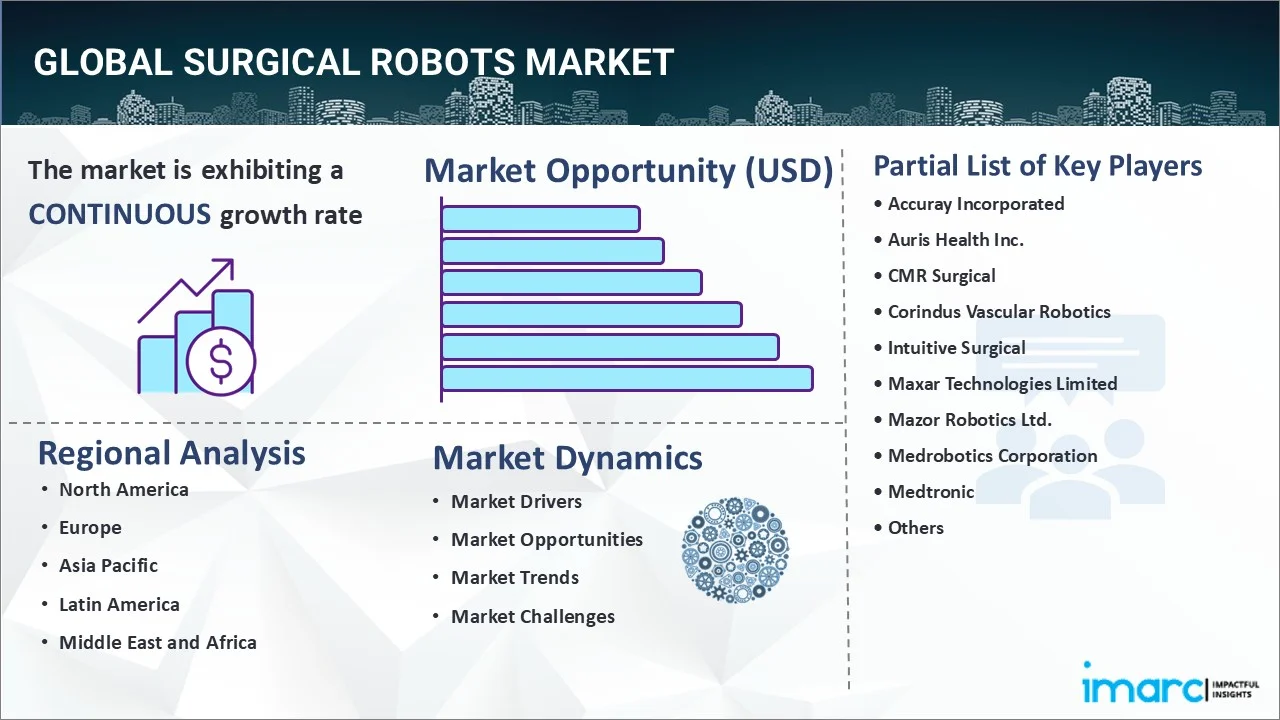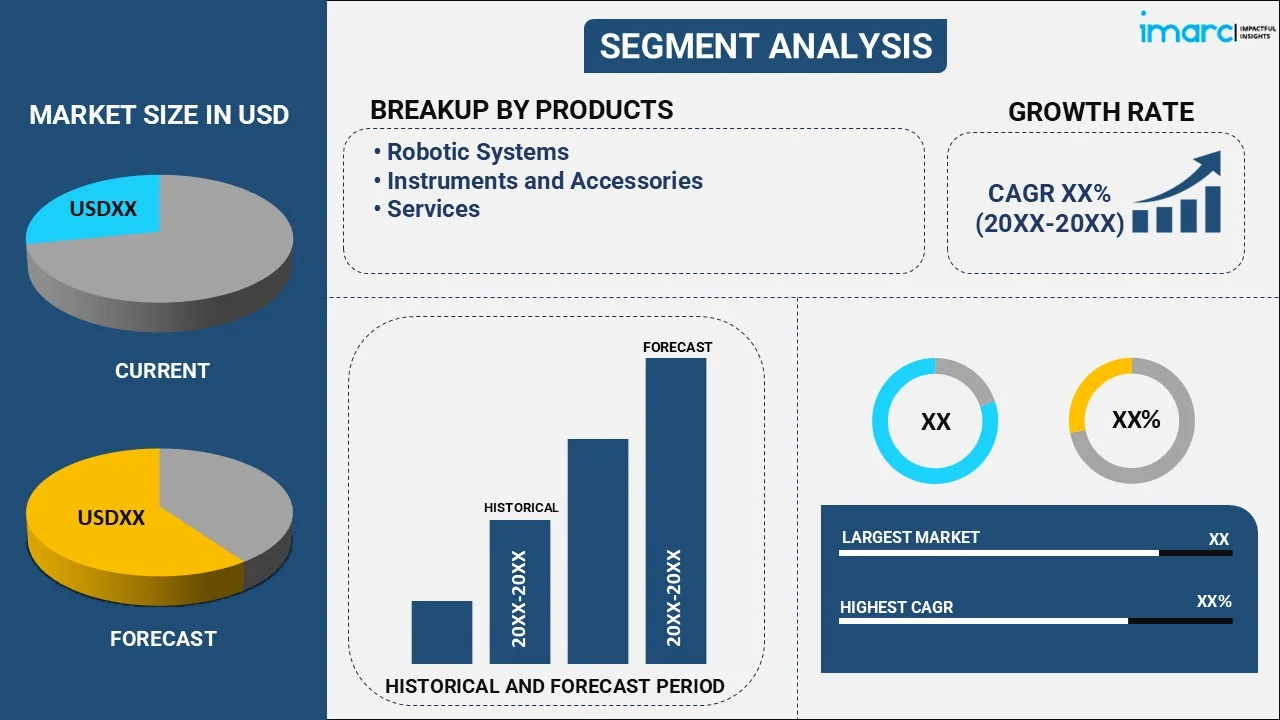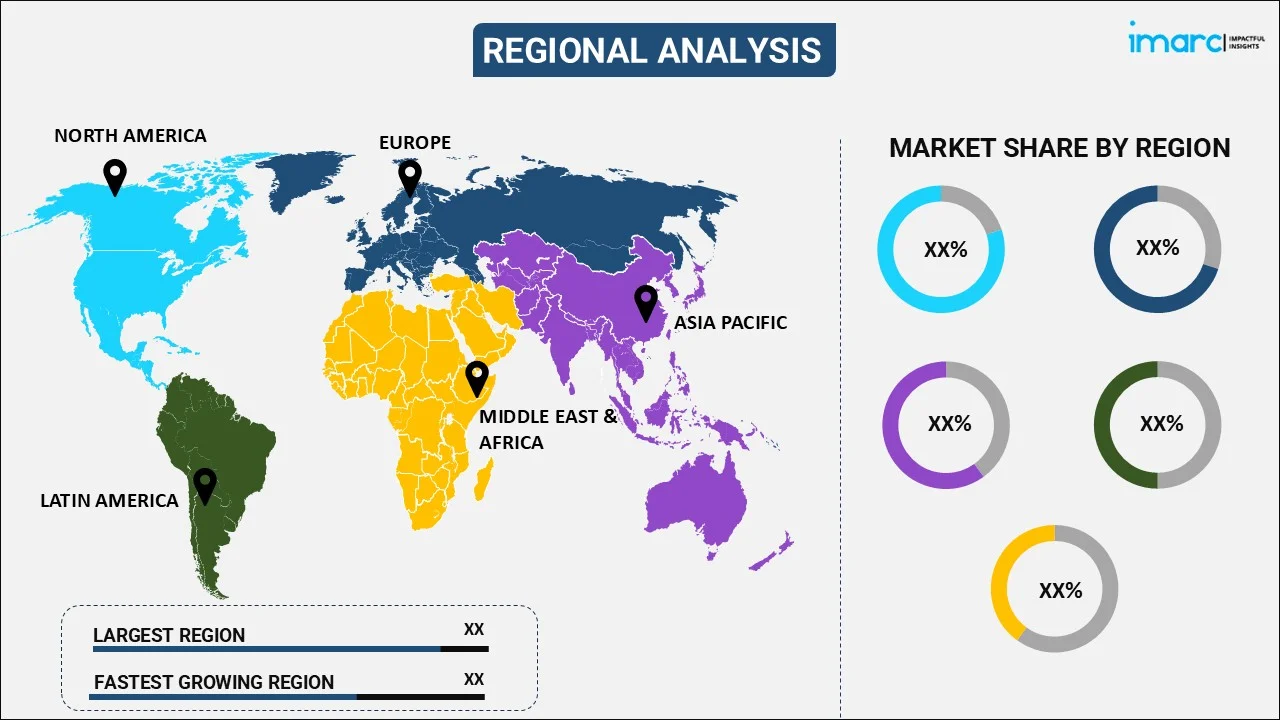
Surgical Robots Market Report by Product (Robotic Systems, Instruments and Accessories, Services), Application (Gynecological Surgery, Urological Surgery, Neurosurgery, Orthopedic Surgery, and Other Applications), End-User (Hospitals, Ambulatory Surgical Centers, and Others), and Region 2025-2033
Global Surgical Robots Market Size, Share & Growth
The global surgical robots market size reached USD 6.2 Billion in 2024. Looking forward, IMARC Group expects the market to reach USD 23.1 Billion by 2033, exhibiting a growth rate (CAGR) of 14.96% during 2025-2033. The growing prevalence of bone degenerative diseases, ongoing advancements in robotic technology, such as improved imaging, navigation systems, and robotic arms with greater dexterity, and rising preference for minimally invasive procedures are primarily driving the market growth.
|
Report Attribute
|
Key Statistics
|
|---|---|
|
Base Year
|
2024
|
|
Forecast Years
|
2025-2033
|
|
Historical Years
|
2019-2024
|
|
Market Size in 2024
|
USD 6.2 Billion |
|
Market Forecast in 2033
|
USD 23.1 Billion |
| Market Growth Rate (2025-2033) | 14.96% |
Global Surgical Robots Market Analysis:
- Major Market Drivers: The increasing prevalence of neurological disorders across the globe is one of the key factors driving the growth of the market. In line with this, the rising geriatric population, which is more susceptible to medical ailments, is also propelling the surgical robots market share.
- Key Market Trends: Various technological advancements and the integration of Artificial Intelligence (AI), the Internet of Things (IoT), and virtual and augmented reality (VR/AR) in the healthcare industry are key market trends for the global surgical robots market. Moreover, increasing funding and investments for research and development (R&D) in the field of robotics and medical sciences is positively impacting the surgical robots market outlook.
- Geographical Landscape: According to the surgical robots market statistics and report by IMARC, North America holds the largest share of the global surgical robot market. The market in the region is growing due to the rising number of surgical procedures associated with colorectal and urological conditions along with the increasing healthcare expenditures. Moreover, in North America, the demand for plastic surgery devices is driven by the high prevalence of cosmetic procedures and the presence of advanced healthcare infrastructures, which is further augmenting the regional market for surgical robots.
- Competitive Landscape: Some of the leading surgical robots market companies include Accuray Incorporated, Auris Health Inc., CMR Surgical, Corindus Vascular Robotics, Intuitive Surgical, Maxar Technologies Limited, Mazor Robotics Ltd., Medrobotics Corporation, Medtronic, Renishaw, Smith & Nephew, SRI International Inc., Stryker Corporation, Think Surgical, Transenterix Inc., Verb Surgical, and Zimmer Biomet, among others.
- Challenges and Opportunities: The surgical robot market faces numerous challenges, such as high initial costs, regulatory hurdles, and the need for specialized training. However, opportunities lie in the growing demand for minimally invasive surgeries, technological advancements improving robot capabilities and increasing adoption in emerging markets.

Global Surgical Robots Market Trends:
Rising Number of Surgeries
The increasing geriatric population across the globe, who are more prone to developing chronic health conditions and surgeries is primarily driving the surgical robots market growth. Furthermore, the growing prevalence of bone degenerative diseases and the rising number of hip & knee replacement surgeries due to increasing cases of arthritis & osteoporosis are driving the global market. For instance, according to the Agency for Healthcare Research and Quality report, over 450,000 hip replacement surgeries are performed annually in the US. Additionally, according to a cardiac surgery market study by iData Research, the number of cardiac surgeries exceeds 900,000 procedures each year in the United States with projections for the number to reach 1.3 million by 2029. The rising prevalence of these conditions is leading to an increase in the number of patients requiring surgeries. Besides this, the escalating number of road accidents across the globe is also contributing to the need for efficient surgical procedures and robots. For instance, as per the report published by the Ministry of Road Transport and Highways, a total of 4,61,312 road accidents were reported by States and Union Territories (UTs) during 2022, which claimed 1,68,491 lives and caused injuries to 4,43,366 persons. This marks an increase of 11.9% in accidents, 9.4% in fatalities, and 15.3% in injuries compared to the previous year. Such a massive rise in the number of surgeries is anticipated to propel the surgical robot market demand in the coming years.
Growing Complexity of Surgical Procedures
The increasing complexity of surgical procedures and the expanding desire for minimally invasive operations with more accuracy and adaptability are further creating a positive outlook for the overall market. Moreover, robotic technology is frequently used in minimally invasive surgeries. As the name implies, these operations all involve small incisions. This technique typically leads to less pain, less blood loss, shorter hospital stays, and quicker recoveries, allowing surgeons to operate on hard-to-reach body parts and get a better view of hidden areas, encouraging patients worldwide to choose robotic surgery and growing market. Besides this, the emerging trend of cosmetic surgery to enhance the physical features of the face is also augmenting the demand for surgery robots that can carry out precise surgical procedures. For instance, RealSelf released its 2023 RealSelf Culture Report, exploring Americans' attitudes toward plastic surgery. The online survey of more than 2,000 respondents of 18 years old and older, revealed that one in four people in America had at least one cosmetic treatment or procedure and that younger generations have experienced a positive plastic surgery shift among social groups. Consequently, the rising number of complex procedures is bolstering the need for automation in the healthcare industry, which in turn will propel the surgical robots market revenue in the coming years.
Ongoing Technological Advancements
The rising technological advancements in the field of robotics are fostering a positive outlook for the overall market. The growing integration of High-definition 3D cameras to provide surgeons with a detailed view of the surgical site and the incorporation of AI algorithms to help surgical robots make real-time adjustments during surgery are some of the significant advancements in robotic surgery development. Such advancements have transformed the way healthcare operates. Moreover, various manufacturers are increasingly investing in the development of advanced robots that can perform complex surgeries with minimal pain. For instance, in March 2024, Intuitive Surgical received an FDA green light for the fifth generation of its multiport da Vinci robot, following more than a decade of research and development. The company said the da Vinci 5 system added more than 150 upgrades over its predecessor, the da Vinci Xi, which received its agency green light in 2016. It includes new controllers for surgeons that offer force feedback, designed to mimic the feel of handheld tools during a procedure. Similarly, in September 2023, US Medical Innovations (USMI) and the Jerome Canady Research Institute for Advanced and Biological Technological Sciences (JCRI-ABTS) announced the launch of the new Canady Robotic AI Surgical System. It is claimed to be the world's first artificial intelligence (AI) robotic system that generates cold atmospheric plasma (CAP) and a three-dimensional non-contact bioelectric pulse electromagnetic field. CAP precisely targets and eliminates microscopic tumor cells during surgery while preserving the health of non-cancerous surrounding tissue. Such advancements are fostering a positive outlook for the market.
Global Surgical Robots Industry Segmentation:
IMARC Group provides an analysis of the key trends in each segment of the global surgical robots market report, along with forecasts at the global, regional and country levels from 2025-2033. Our report has categorized the market based on product, application, and end-user.
Breakup by Product:

- Robotic Systems
- Instruments and Accessories
- Services
Instruments and accessories hold the majority of the total market share
A detailed breakup and analysis of the market based on the product has also been provided in the report. This includes robotic systems, instruments and accessories, and services. According to the report, instruments and accessories hold the majority of the total market share.
Surgical robots use a variety of specialized instruments to perform procedures with precision and accuracy. These instruments are typically mounted on robotic arms and controlled by the surgeon using a console. Graspers, scissors, needle drivers, retractors, and suction tools are some of the common instruments found in surgical robots. Moreover, these instruments work together to enable surgeons to perform a wide range of procedures with greater precision, control, and less invasive techniques than traditional surgery.
Breakup by Application:
- Gynecological Surgery
- Urological Surgery
- Neurosurgery
- Orthopedic Surgery
- Other Applications
Orthopedic surgery currently exhibits a clear dominance in the market
A detailed breakup and analysis of the market based on the application has also been provided in the report. This includes gynecological surgery, urological surgery, neurosurgery, orthopedic surgery, and other applications. According to the report, orthopedic surgery currently exhibits a clear dominance in the market.
The increasing geriatric population across the globe, which is more prone to developing joint and muscle-related issues, is primarily driving the growth of this segment. According to the Australian Institute of Health and Welfare (AIHW) statistics, the total knee replacement rate for osteoarthritis increased by about 38% from 2005-2006 to 2017-2018. Moreover, as per the International Congress for Joint Reconstruction in March 2018, total number of primary hip replacement and knee replacement procedures is projected to reach 635,000 (171.0% increase) & 1.28 million (189.0% increase), respectively, by 2030 and 1.23 million (330.0% growth) & 2.60 million (382.0% growth) by 2060. Such a massive rise in the number of orthopedic surgeries is leading to the dominance of this segment.
Breakup by End-User:
- Hospitals
- Ambulatory Surgical Centers
- Others
Hospitals account for the largest market share
A detailed breakup and analysis of the market based on the end-user has also been provided in the report. This includes hospitals, ambulatory surgical centers, and others. According to the report, hospitals account for the largest market share.
Inpatient facilities, such as hospitals, usually have the financial resources and high patient volume to justify the investment in costly surgical robotic systems. In addition, they possess the infrastructure and skilled personnel necessary to operate and maintain these advanced technologies.
Breakup by Region:

- North America
- United States
- Canada
- Asia Pacific
- China
- Japan
- India
- South Korea
- Australia
- Indonesia
- Others
- Europe
- Germany
- France
- United Kingdom
- Italy
- Spain
- Russia
- Others
- Latin America
- Brazil
- Mexico
- Others
- Middle East and Africa
North America holds the largest market share
A detailed breakup and analysis of the market based on the region has also been provided in the report. This includes North America, Asia Pacific, Europe, Latin America, and Middle East and Africa. According to the report, North America currently dominates the global market.
North America holds the largest share of the global surgical robot market. The market in the region is growing due to the rising number of surgical procedures associated with colorectal and urological conditions and increasing healthcare expenditures. Moreover, in North America, the demand for General & Plastic Surgery Devices is driven by the high prevalence of cosmetic procedures and advanced healthcare infrastructure. Besides this, each year in the United States, surgeons perform approximately 64 million surgical procedures, ranging from tooth extraction to open heart surgery. Furthermore, various regional manufacturers are increasingly investing in the development of advanced surgical robots, which is creating a positive outlook for the market. For instance, in September 2024, Medtronic announced the launch of a new robot-assisted surgery platform that is more flexible and cost-effective than systems presently on the market.
Competitive Landscape:
The global surgical robots market is highly fragmented with the presence of several small and large players competing in terms of price and quality. Some of the major players in the market are:
- Accuray Incorporated
- Auris Health Inc.
- CMR Surgical
- Corindus Vascular Robotics
- Intuitive Surgical
- Maxar Technologies Limited
- Mazor Robotics Ltd.
- Medrobotics Corporation
- Medtronic
- Renishaw
- Smith & Nephew
- SRI International Inc.
- Stryker Corporation
- Think Surgical
- Transenterix Inc.
- Verb Surgical
- Zimmer Biomet
(Please note that this is only a partial list of the key players, and the complete list is provided in the report.)
Surgical Robots Market Recent Developments:
- March 2024: Intuitive Surgical received an FDA green light for the fifth generation of its multiport da Vinci robot, following more than a decade of research and development. The company said the da Vinci 5 system adds more than 150 upgrades over its predecessor, the da Vinci Xi, which received its agency green light in 2016.
- February 2024: Agilis Robotics, a leading innovator in surgical robotics, unveiled groundbreaking advancements in endoluminal surgery. The company has made remarkable technological breakthroughs in developing highly miniaturized and flexible robotic instruments that offer exceptional dexterity even in the most challenging anatomies. This achievement empowers surgeons to perform intricate tissue resection procedures with precision and ease, directly within natural orifices.
- July 2023: Governor S Abdul Nazeer inaugurated the state-of-the-art 4th Gen Da Vinci X Robotic-assisted surgery unit at Manipal Hospital. The launch of robotics-assisted surgery is a groundbreaking milestone for Andhra Pradesh and would mark a remarkable forward in healthcare technology.
Surgical Robots Market Report Coverage:
| Report Features | Details |
|---|---|
| Base Year of the Analysis | 2024 |
| Historical Period | 2019-2024 |
| Forecast Period | 2025-2033 |
| Units | Billion USD |
| Segment Coverage | Product, Application, End-User, Region |
| Regions Covered | Asia Pacific, Europe, North America, Latin America, Middle East and Africa |
| Countries Covered | United States, Canada, Germany, France, United Kingdom, Italy, Spain, Russia, China, Japan, India, South Korea, Australia, Indonesia, Brazil, Mexico |
| Companies Covered | Accuray Incorporated, Auris Health Inc., CMR Surgical, Corindus Vascular Robotics, Intuitive Surgical, Maxar Technologies Limited, Mazor Robotics Ltd., Medrobotics Corporation, Medtronic, Renishaw, Smith & Nephew, SRI International Inc., Stryker Corporation, Think Surgical, Transenterix Inc., Verb Surgical, and Zimmer Biomet |
| Customization Scope | 10% Free Customization |
| Post-Sale Analyst Support | 10-12 Weeks |
| Delivery Format | PDF and Excel through Email (We can also provide the editable version of the report in PPT/Word format on special request) |
Key Benefits for Stakeholders:
- IMARC’s report offers a comprehensive quantitative analysis of various market segments, historical and current market trends, market forecasts, and dynamics of the surgical robots market from 2019-2033.
- The research study provides the latest information on the market drivers, challenges, and opportunities in the global surgical robots market.
- The study maps the leading, as well as the fastest-growing, regional markets. It further enables stakeholders to identify the key country-level markets within each region.
- Porter's five forces analysis assist stakeholders in assessing the impact of new entrants, competitive rivalry, supplier power, buyer power, and the threat of substitution. It helps stakeholders to analyze the level of competition within the surgical robots industry and its attractiveness.
- Competitive landscape allows stakeholders to understand their competitive environment and provides an insight into the current positions of key players in the market.
Key Questions Answered in This Report
The global surgical robots market was valued at USD 6.2 Billion in 2024.
We expect the global surgical robots market to exhibit a CAGR of 14.96% during 2025-2033.
The rising adoption of surgical robots, as they offer faster recovery time, minimal post-operative discomfort, and reduced risks of infection and scars than traditional surgeries, is primarily driving the global surgical robots market.
The sudden outbreak of the COVID-19 pandemic had led to the increasing adoption of surgical robots to combat the spread of the coronavirus infection upon interaction with healthcare professionals, thereby positively influencing the global market.
Based on the product, the global surgical robots market can be bifurcated into robotic systems, instruments and accessories, and services. Currently, instruments and accessories hold the majority of the total market share.
Based on the application, the global surgical robots market has been segmented into gynecological surgery, urological surgery, neurosurgery, orthopedic surgery, and other applications. Among these, orthopedic surgery currently exhibits a clear dominance in the market.
Based on the end-user, the global surgical robots market can be divided into hospitals, ambulatory surgical centers, and others. Currently, hospitals account for the largest market share.
On a regional level, the market has been classified into North America, Asia Pacific, Europe, Latin America, and Middle East and Africa, where North America currently dominates the global market.
Some of the major players in the global surgical robots market include Accuray Incorporated, Auris Health Inc., CMR Surgical, Corindus Vascular Robotics, Intuitive Surgical, Maxar Technologies Limited, Mazor Robotics Ltd., Medrobotics Corporation, Medtronic, Renishaw, Smith & Nephew, SRI International Inc., Stryker Corporation, Think Surgical, Transenterix Inc., Verb Surgical, Zimmer Biomet, etc.
Need more help?
- Speak to our experienced analysts for insights on the current market scenarios.
- Include additional segments and countries to customize the report as per your requirement.
- Gain an unparalleled competitive advantage in your domain by understanding how to utilize the report and positively impacting your operations and revenue.
- For further assistance, please connect with our analysts.
 Request Customization
Request Customization
 Speak to an Analyst
Speak to an Analyst
 Request Brochure
Request Brochure
 Inquire Before Buying
Inquire Before Buying




.webp)




.webp)












